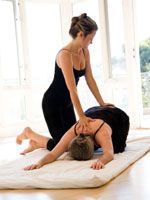When you're wrapped up in, say, Plow Pose, it's hard to see your own body. You may think your leg is straight when really it's all askew. Your teacher's in-class adjustments are some of the best benefits of regularly attending a yoga class. They help you perfect your form, yet many of my students have told me they don't know how to respond to their teacher's touch.
 yoga-instructor-touch
yoga-instructor-touch
If your teacher adjusts you mid-sequence, go with the direction of her touch. If she gently moves you to the left, work with her. I have had some students not move at all when I try to adjust them. At first I thought this was insubordination! After speaking with them, I realized they just didn't know what they were supposed to do. They thought—and I kid you not—that an adjustment was just like a massage, so they went limp and relaxed when I did all the work!
You need to "get strong" in the direction that the teacher is leading you. If the teacher does all the work, it defeats the purpose for you. And although you certainly shouldn't go limp, it's important to soften a bit and breathe while you get the idea of what the teacher is showing you.
Yoga teachers are taught to put their hands on students a lot as a way of giving, guiding, and teaching. But that doesn't mean you have to embrace our hands-on approach. If you have an injury or don't like to be touched for any reason (you don't even need a good reason), make sure to tell the teacher at the beginning of class so she isn't caught off guard when she attempts to guide you. Likewise, if there is a particular pose that you are having trouble with, you can speak up about that too. Be sure to do this ahead of time so the flow of the class isn't broken.
